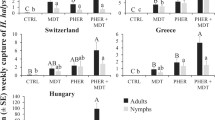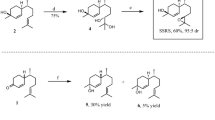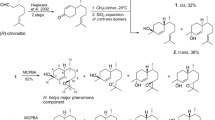Abstract
The brown marmorated stink bug, Halyomorpha halys, is considered a serious invasive species capable of causing significant agricultural and nuisance problems. Researchers in the USA recently identified the two-component H. halys aggregation pheromone from populations in North America and found that when it is combined with the pheromone synergist methyl decatrienoate (MDT), it resulted in reliable, season-long captures of H. halys throughout the USA. However, no study has assessed whether H. halys populations in the native range are attracted to and can also be reliably captured by the combination of these stimuli. In this study, our goal was to evaluate the response of H. halys adults, nymphs, and non-target organisms to traps baited with the aggregation pheromone, MDT alone, or in combination at three locations in the native range. Traps baited with combined stimuli reliably captured the greatest numbers of H. halys adults and nymphs, and traps baited with either lure treatment caught a unique community of non-target organisms. In addition, Plautia stali was cross-attracted to the H. halys aggregation pheromone. Overall, we demonstrate that the pheromone-based tools developed in the USA may be used for worldwide detection and surveillance programs for H. halys and P. stali.






Similar content being viewed by others
References
Adachi I, Uchino K, Mochizuki F (2007) Development of a pyramidal trap for monitoring fruit-piercing stink bugs baited with Plautia crossota stali (Hemiptera: Pentatomidae) aggregation pheromone. Appl Entomol Zool 42:425–431
Adati T, Tatsuki S (1999) Identification of female sex pheromone of the legume pod borer, Maruca vitrata and antagonistic effects of geometrical isomers. J Chem Ecol 25:105–115
Aldrich JR, Hoffmann MP, Kochansky JP, Lusby WR, Eger JE, Payne JA (1991) Identification and attractiveness of the major pheromone component for Nearctic Euschistus spp. stink bugs (Heteroptera: Pentatomidae). Environ Entomol 20:477–483
Aldrich JR, Khrimian A, Camp M (2007) Methyl 2,4,6-decatrienoates attract stink bugs and tachinid parasitoids. J Chem Ecol 33:801–815
Anderson MJ (2008) ControlChart: a FORTRAN computer program for calculating control charts for multivariate response data through time, based on a chosen resemblance measure. University of Auckland, Auckland
Australian Government (2015) Brown marmorated stink bug: emergency measures for break bulk and containerised vehicles, machinery, automotive parts, and tyres. Department of Agriculture and Water Resources, Australian Government, Canberry City, Australia
Baker AJ, Moeed A (1987) Rapid genetic differentiation and founder effect in colonizing populations of common mynas (Acridotheres tristis). Evolution 41:525
Blaauw BR, Polk D, Nielsen AL (2015) IPM-CPR for peaches: incorporating behaviorally-based methods to manage Halyomorpha halys and key pests in peach. Pest Manag Sci 71:1513–1522
Blossey B, Notzold R (1995) Evolution of increased competitive ability in invasive nonindigenous plants: a hypothesis. J Ecol 83(5):887
Borges M, Moraes MCB, Peixoto MF, Pires CSS, Sujii ER, Laumann RA (2011) Monitoring the Neotropical brown stink bug Euschistus heros (F.) (Hemiptera: Pentatomidae) with pheromone-baited traps in soybean fields. J Appl Entomol 135:68–80
Clarke KR (1993) Non-parametric multivariate analyses of changes in community structure. Aust J Ecol 18:117–143
Cottrell TE, Landolt PJ, Zhang Q-H, Zack RS (2014) A chemical lure for stink bugs (Hemiptera: Pentatomidae) is used as a kairomone by Astata occidentalis (Hymenoptera: Sphecidae). Fla Entomol 97:233–237
Dixon P (2003) VEGAN, a package of R functions for community ecology. J Veg Sci 14:927–930
Dlugosch KM, Parker IM (2008) Founding events in species invasions: genetic variation, adaptive evolution, and the role of multiple introductions. Mol Ecol 17:431–449
Endo N, Sasaki R, Muto S (2010) Pheromonal cross-attraction in true bugs (Heteroptera): Attraction of Piezodorus hybneri (Pentatomidae) to its pheromone versus the pheromone of Riptortus pedestris (Alydidae). Environ Entomol 39:1973–1979
Funayama K (2003) Outbreak and control of stink bugs in apple orchards. Jpn Agric Tech 47:35–39
Funayama K (2008) Seasonal fluctuations and physiological status of Halyomorpha halys (Stal) adults captured in traps baited with synthetic aggregation pheromone of Plautia crossota stali Scott. Jpn J Appl Entomol Z 52:69–75
Gariepy TD, Fraser H, Scott-Dupree CD (2014) Brown marmorated stink bug (Hemiptera: Pentatomidae) in Canada: recent establishment, occurrence, and pest status in southern Ontario. Can Entomol 146:579–582
Haye T, Gariepy T, Hoelmer K, Rossi J-P, Streito J-C, Tassus X, Desneux N (2015) Range expansion of the invasive brown marmorated stinkbug, Halyomorpha halys: an increasing threat to field, fruit and vegetable crops worldwide. J Pest Sci 88:665–673
Herlihly MV, Talamas EJ, Weber DC (2016) Attack and success of native and exotic parasitoids on eggs of Halymorpha halys in three Maryland habitats. PLoS ONE 11:e0150275
Hoebeke ER, Carter ME (2003) Halyomorpha halys (Stål) (Heteroptera: Pentatomidae): a polyphagous plant pest from Asia newly detected in North America. Proc Entomol Soc Wash 105:225–237
Ioannidis P et al (2014) Rapid transcriptome sequencing of an invasive pest, the brown marmorated stink bug, Halyomorpha halys. BMC Genom 15:738–760
Jones AL, Jennings DE, Hooks CRR, Shrewsbury PM (2014) Sentinel eggs underestimate rates of parasitism of the exotic brown marmorated stink bug, Halyomorpha halys. Biol Control 78:61–66
Joseph SV, Bergh CJ, Wright SE, Leskey TC (2013) Factors affecting captures of brown marmorated stink bug, Halyomorpha halys (Hemiptera: Pentatomidae), in baited pyramid traps. J Entomol Sci 48:43–51
Kelly JA, Avery TS, Stewart DT, Cutler CG, Gaul SO, MacKenzie KE, Hillier NK (2013) Non-target Gelechiidae and Noctuidae attraction to Aroga trialbamaculella (Lepidoptera: Gelechiidae) pheromone-based trapping systems. Can Entomol 145:48–52
Khrimian A, Shearer PW, Zhang A, Hamilton GC, Aldrich JR (2008) Field trapping of the invasive brown marmorated stink bug, Halyomorpha halys, with geometric isomers of methyl-2,4,6-decatrienoate. J Agric Food Chem 56:197–203
Khrimian A et al (2014) Discovery of the aggregation pheromone of the brown marmorated stink bug (Halyomorpha halys) through the creation of stereoisomeric libraries of 1-bisabolen-3-ols. J Nat Prod 77:1708–1717
Lara J et al (2016) Biological control program is being developed for brown marmorated stink bug. Calif Agric 70:15–23
Lee CE (2002) Evolutionary genetics of invasive species. Trends Ecol Evol 17:386–391
Lee D-H (2015) Current status of research progress on the biology and management of Halyomorpha halys (Hemiptera: Pentatomidae) as an invasive species. Appl Entomol 50:277–290
Lee DH, Leskey TC (2015) Flight behavior of foraging and overwintering brown marmorated stink bug, Halyomorpha halys (Hemiptera: Pentatomidae). Bull Entomol Res 105:566–573
Lee DH, Short BD, Joseph SV, Bergh JC, Leskey TC (2013) Review of the biology, ecology, and management of Halyomorpha halys (Hemiptera: Pentatomidae) in China, Japan, and the Republic of Korea. Environ Entomol 42:627–641
Leskey TC et al (2012a) Pest status of the brown marmorated stink bug, Halyomorpha halys in the USA. Outlooks Pest Manag 23:218–226
Leskey TC, Short BD, Butler BR, Wright SE (2012b) Impact of the invasive brown marmorated stink bug, Halyomorpha halys (Stål), in mid-Atlantic tree fruit orchards in the United States: Case studies of commercial management. Psyche 2012:1–14
Leskey TC, Wright SE, Short BD, Khrimian A (2012c) Development of behaviorally-based monitoring tools for the brown marmorated stink bug (Heteroptera: Pentatomidae) in commercial tree fruit orchards. J Entomol Sci 47:76–85
Leskey TC, Short BD, Lee DH (2014) Efficacy of insecticide residues on adult Halyomorpha halys (Stål) (Hemiptera: Pentatomidae) mortality and injury in apple and peach orchards. Pest Manag Sci 70:1097–1104
Leskey TC et al (2015a) Attraction of the invasive Halyomorpha halys (Hemiptera: Pentatomidae) to traps baited with semiochemical stimuli across the United States. Environ Entomol 44:746–756
Leskey TC, Khrimian A, Weber DC, Aldrich JR, Short BD, Lee DH, Morrison WR (2015b) Behavioral responses of the invasive Halyomorpha halys (Stal) to traps baited with stereoisomeric mixtures of 10,11-epoxy-1-bisabolen-3-ol. J Chem Ecol 41:418–429
Leskey TC, Lee DH, Glenn DM, Morrison WR (2015c) Behavioral responses of the invasive Halyomorpha halys (Stal) (Hemiptera: Pentatomidae) to light-based stimuli in the laboratory and field. J Insect Behav 28:674–692
Linn CE, Young MS, Gendle M, Glover TJ, Roelofs WL (1997) Sex pheromone blend discrimination in two races and hybrids of the European corn borer moth, Ostrinia nubilalis. Physiol Entomol 22:212–223
MacLellan R (2013) Brown marmorated stink bug: a potential risk to New Zealand. Surveillance 40:34–36
Mason LJ, Jansson RK, Heath RR (1990) Sampling range of male sweetpotato weevils (Cylas formicarius elegantulus) (Summers) (Coleoptera: Curculionidae) to pheromone traps: influence of pheromone dosage and lure age. J Chem Ecol 16:2493–2502
Millar JG, Rice RE, Steffan SA, Daane KM, Cullen E, Zalom FG (2001) Attraction of female digger wasps, Astata occidentalis Cresson (Hymneoptera: Sphecidae) to the sex pheromone of the bug Thyanta pallidovirens (Hemiptera: Pentatomidae). Pan Pac Entomol 77:244–248
Morrison WR, Cullum JP, Leskey TC (2015) Evaluation of trap designs and deployment strategies for capturing Halyomorpha halys (Hemiptera: Pentatomidae). J Econ Entomol 108:1683–1692
Morrison WR, Lee D-H, Reissig WH, Combs D, Leahy K, Poling B, Leskey TC (2016a) Inclusion of specialist and generalist stimuli in attract-and-kill programs: their relative efficacy in apple maggot fly (Diptera: Tephritidae) pest management. Environ Entomol 45:974–982
Morrison WR, Lee DH, Short BD, Khrimian A, Leskey TC (2016b) Establishing the behavioral basis for an attract-and-kill strategy to manage the invasive Halyomorpha halys in apple orchards. J Pest Sci 89:81–96
Morrison WR, Mathews CR, Leskey TC (2016c) Frequency, efficiency, and physical characteristics of predation by generalist predators of brown marmorated stink bug (Hemiptera: Pentatomidae) eggs. Biol Control 97:120–130
Morrison WR, Poling B, Leskey TC (2016d) The consequences of sublethal exposure to insecticide on the survivorship and mobility of Halyomorpha halys (Hemiptera: Pentatomidae). Pest Manag Sci. doi:10.1002/ps.4322
Nielsen AL, Holmstrom K, Hamilton GC, Cambridge J, Ingerson-Mahar J (2013) Use of black light traps to monitor the abundance, spread, and flight behavior of Halyomorpha halys (Hemiptera: Pentatomidae). J Econ Entomol 106:1495–1502
Park G-M, Jang S-A, Choi S-H, Park C-G (2010) Attraction of Plautia stali (Hemiptera: Pentatomidae) to different amounts of its aggregation pheromone and the effect of different dispensers. Korean J Appl Entomol 49:123–127
Phillips BL, Brown GP, Shine R (2010) Life-history evolution in range-shifting populations. Ecology 91:1617–1627
Porter SD, Savignano DA (1990) Invasion of polygyne fire ants decimates native ants and disrupts arthropod community. Ecology 71:2095–2106
Rice KB et al (2014) Biology, ecology, and management of brown marmorated stink bug (Hemiptera: Pentatomidae). J Integr Pest Manag 5:1–13
Roelofs WL et al (1987) Sex pheromone production and perception in European corn borer moths is determine by both autosomal and sex-linked genes. Proc Natl Acad Sci USA 84:7585–7589
Short BD, Khrimian A, Leskey TC (2016) Pheromone-based decision support tools for management of Halyomorpha halys in apple orchards: development of a trap-based treatment threshold. J Pest Sci. doi:10.1007/s10340-016-0812-1
Son C-K, Park SG, Hwang Y-H, Choi B-S (2000) Field occurrence of stink bug and its damage in soybean. Korean J Crop Sci 45:405–410
Sugie H et al (1996) Identification of the aggregation pheromone of the brown-winged green bug, Plautia stali Scott (Heteroptera: Pentatomidae). Appl Entomol Zool 31:427–431
Talamas EJ, Herlihly MV, Dieckhoff C, Hoelmer K, Buffington M, Bon M-C, Weber DC (2015) Trissolcus japonicus (Ashmead) (Hymenoptera: Scelionidae) emerges in North America. J Hymenopt Res 43:119–128
R Core Development Team (2015) R: a Language and environment for statistical computing. http://www.R-project.org/
Tillman PG, Aldrich JR, Khrimian A, Cottrell TE (2010) Pheromone attraction and cross-attraction of Nezara, Ascosternum, and Euschistus spp. stink bugs (Heteroptera: Pentatomidae) in the field. Environ Entomol 39:610–617
Tsutsui ND, Case TJ (2001) Population genetics and colony structure of the argentine ant (Linepithema humile) in its native and introduced ranges. Evolution 55:976
Van der Kraan C, Ebbers A (1990) Release rates of tetradecen-1-ol acetates from polymeric formulations in relation to temperature and air velocity. J Chem Ecol 16:1041–1058
Vet LEM, Dicke M (1992) Ecology of infochemical use by natural enemies in a tritrophic context. Annu Rev Entomol 37:141–172
Vilà M, Maron JL, Marco L (2005) Evidence for the enemy release hypothesis in Hypericum perforatum. Oecologia 142:474–479
Weber DC, Leskey TC, Walsh GC, Khrimian A (2014a) Synergy of aggregation pheromone with methyl (E, E, Z)-2,4,6-decatrienoate in attraction of Halyomorpha halys (Hemiptera: Pentatomidae). J Econ Entomol 107:1061–1068
Weber DC, Walsh GC, DiMeglio AS, Athanas MM, Leskey TC, Khrimian A (2014b) Attractiveness of harlequin bug, Murgantia histrionica, aggregation pheromone: field response to isomers, ratios, and dose. J Chem Ecol 40:1251–1259
Wermelinger B, Wyniger D, Forster B (2008) First records of an invasive bug in Europe: Halyomorpha halys Stal (Heteroptera: Pentatomidae), a new pest on woody ornamentals and fruit trees? Mitt Schweiz Entomol Ges 81:1–8
Wertheim B, van Baalen E-J, Dicke M, Vet LEM (2005) Pheromone-mediated aggregation in nonsocial arthropods: an evolutionary ecological perspective. Annu Rev Entomol 50:321–346
Xu J, Fonseca DM, Hamilton GC, Hoelmer KA, Nielsen AL (2013) Tracing the origin of US brown marmorated stink bugs, Halyomorpha halys. Biol Invasions 16:153–166
Yee WL, Nash MJ, Goughnour RB, Cha DH, Linn CE, Feder JL (2014) Ammonium carbonate is more attractive than apple and hawthorn fruit volatile lures to Rhagoletis pomonella (Diptera: Tephritidae) in Washington State. Environ Entomol 43:957–968
Zangerl AR, Berenbaum MR (2005) Increase in toxicity of an invasive weed after reassociation with its coevolved herbivore. Proc Natl Acad Sci 102:15529–15532
Acknowledgements
We would like to thank J.J. Ahn (West Virginia University), J. Cullum (USDA), J.T. Goldner, Dr. Sang-Ku Lee, and M.M. McKinney for their excellent technical assistance. This work was funded by a Cooperative Research Program for between Agricultural Science and the Technology Development and the Rural Development Administration, Republic of Korea (Project No. PJ008946), Cooperative Research Agreement between the Rural Development Administration of the Republic of Korea and West Virginia University, USA (Project No. 10016999) and National Research Foundation of Korea (Grant No. NRF-2014R1A1A2056993). This research was also funded, in part, by a USDA-NIFA SCRI CAP Grant#2011-51181-30937. Mention of trade names or commercial products in this publication is solely for the purpose of providing scientific information and does not imply recommendation or endorsement by the US Department of Agriculture.
Author information
Authors and Affiliations
Corresponding author
Ethics declarations
Conflict of interest
All authors declare that they have no conflict of interest in publishing this work.
Human and animal rights
All applicable international, national, and/or institutional guidelines for the care and use of animals were followed. This article does not contain any studies with human participants by any of the authors.
Additional information
Communicated by T. Haye.
Special Issue: The brown marmorated stink bug Halyomorpha halys - an emerging pest of global concern
Rights and permissions
About this article
Cite this article
Morrison III, W.R., Park, CG., Seo, B.Y. et al. Attraction of the invasive Halyomorpha halys in its native Asian range to traps baited with semiochemical stimuli. J Pest Sci 90, 1205–1217 (2017). https://doi.org/10.1007/s10340-016-0816-x
Received:
Revised:
Accepted:
Published:
Issue Date:
DOI: https://doi.org/10.1007/s10340-016-0816-x




